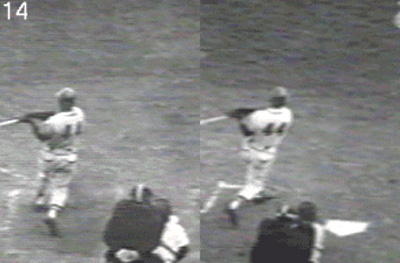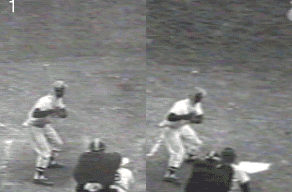Coiling and Uncoiling

 Much has been said about Bat Speed and how to develop it. Although it is obvious that the size and strength of the individual swinging the bat has a direct impact on the swing speed, there are certain mechanical factors involved that also have a significant impact.
Much has been said about Bat Speed and how to develop it. Although it is obvious that the size and strength of the individual swinging the bat has a direct impact on the swing speed, there are certain mechanical factors involved that also have a significant impact.
Given two individuals of the same size and strength, it is entirely possible to have two vastly different bat speeds registered simply as a result of how the bats were swung. Even if both participants are swinging as hard as possible. That being said, let’s turn our attention to the sequence of photos involving the legendary Henry Aaron.
In the photos to the left, it appears that Henry hits a tremendous homerun to left field on an inside pitch. On the right, he hits a tremendous blast to right field on a pitch to the middle portion of the plate. Although the camera angles are minutely different, it does not appear that Henry changes much at all in the two swings. In fact, to the untrained eye, there seems to be no change in the upper body action. If you look closely however, you will see something remarkable…. Bat Speed and how to get it!!
In the frames to the left the bat traveled farther, yet arrived in the impact zone before the bat in the frames to the right. How did he do that? I’ll tell you… he uncoiled the spring!!
Coiling and Uncoiling creates Bat Speed. Certainly there are other components, but this is the key ingredient. Just as there are different components to an omelet and eggs over easy, the key ingredient is still eggs. Coiling and Uncoiling is the key ingredient in the recipe for Bat Speed. Let’s analyze the upper body in each frame, we will take an up-close look at the lower body action later in the article.
First, you can see that there is no difference in the preparation of the upper body in either side. During the coiling, or loading phase (frames 1-6), there is absolutely nothing different about the two swings. Although it is clear that Henry was fully aware of the location of each pitch (inside in frames to the left, middle in frames to the right) by the 3rd frame, he made no alterations in his upper body preparation to compensate for pitch location.
Think about that.
He knew where the pitch would be and changed nothing in the loading of the bat… nothing. I am willing to bet that if we watched video of Henry in 100 at-bats, we would see exactly the same preparation in each at-bat! He coiled the spring exactly the same each time. This from a man that hit more homeruns than any player in history. He also starts the swing exactly the same (frame 6). It is only in frame 7 that we see a noticeable difference in the action of the upper body. The difference is in the rotation of the shoulders and the action of the right elbow.
Notice the right elbow in frame 7 of each sequence. On the swing to the left, the elbow is tucking in. This does not happen until frame 8 in the swing to the right. That movement is directly related to the uncoiling action. In order to hit the pitch on the left, Henry was required to uncoil fractions sooner to create enough torque to propel the bat head into the impact area. You can see that, in frame 9 of each swing, the head of the bat is in nearly the identical location and position. But, by frame 10 the bat on the left has traveled significantly farther! You can really see this in frame 11. How did he do that? Uncoiling. He created acceleration in the bat head by accentuating the shoulder and hip turn.
The combination of those moving parts, the forces he created by tucking the elbow close to the body and allowing the weight of the bat head to rotate around the center point, created bat speed. The quickness with which he rotated his shoulders and hips in frame 7 started those forces in motion. But, believe it or not, he set all of these forces up in frames 3-6 with his lower body! Remember that Henry knew where the pitch was going to be by frame 3 in each sequence. This early pitch recognition is paramount to a hitter’s timing (the key ingredient to successful hitting). Henry prepared himself identically with the upper body. However, in frame 3, Henry realizes that he will have to position himself differently to create the proper angle of attack for each individual pitch. He does this by simply placing his foot in two different locations in the batter’s box. Lower body adjustment!
This simple move allows for the proper angles and forces to be implemented when he uncoils on the pitch. The lower body preparation in frames 3-6 make all the difference in the bat speed Henry creates. By placing his front foot slightly to the left, Henry allowed his hips room to rotate. Had he stepped in the same location as in the picture to the right, the angles and forces would not have been possible to achieve. He would probably have been jammed on the inside portion of the handle because the bat speed would not have been great enough to beat the ball to the impact zone. He could not have uncoiled quickly enough. He could not have created the angle.
Look at frame 10 very closely. This is the point of impact in each sequence. Do not look at the shoulders or the front foot location. Instead, study the angle created between his front foot and the ball at impact. They are nearly identical! This is the angle Henry “saw” when he recognized the pitch in frame 3. He began positioning his body to reach this angle at the point of impact. It is at this angle that the forces generated in the uncoiling are at their greatest, i.e.; Bat Speed!
We don’t need to discuss the incredible hand-eye coordination of the greatest homerun hitter, he had bundles of it, but every player has the ability to create the proper angles. This is the goal of the mechanics in a swing.
Now, to the mechanics of the coiling and uncoiling, the heart of bat speed development; in frames 1-6 in each sequence the upper body is going back toward the catcher. It finally starts forward in frame 7. The lower body begins its forward rotation in frame 5! But, it begins its forward motion as early as frame 2! In frames 2-5 the lower body is moving forward and the upper body is moving back (A key element to mention here is that the weight never, at any point in either sequence, gets outside of Henry’s rear leg. The weight is always on the inside, creating tension for the coiling and uncoiling). These opposite forces are creating energy, which is further enhanced by the lower body rotation in frames 5-6. This is all the coiling phase, even though the lower body is beginning to unwind as the front heel hits the ground in frame 5. The upper body is still “staying back” (you’ve heard that before), creating even more tension, ready to uncoil in frame 7. The body parts moving in opposite directions are the keys to creating bat speed.
Now, each person’s anatomy is different and many factors come into play in regards to how far one person can coil in relation to another. But the coiling and uncoiling are at the heart of creating bat speed. Other factors have an affect as well, such as the same forces taking place in the hand action, strength of the hands and forearms, fast-twitch muscle fibers, etc. The key ingredient though (the eggs in the recipe) is the ability to coil properly.
The neat thing about this move is that it can be instilled in muscle memory without ever stepping foot on a baseball field. You can learn it right in your bedroom with a simple drill. By repeating the drill over and over in front of a mirror, you can learn the coiling action needed to create great bat speed.
So, what have we learned from this article?
- The upper body action does not change, regardless of pitch location, during the coiling phase.
- That the lower body makes the adjustments regarding pitch location.
- That the coiling is the movement in opposite directions of the two body halves.
- That there is an optimum angle of impact to redeem the full power of the uncoiling effect.
- That the rear elbow plays a key part in imparting the correct forces on the bat head.
- That Henry Aaron did not squish the bug!! That’s another story! I hope this helps you to Be A Better Hitter!

About your comments on {COILING and UNCOILING} during the approach to contact, Following Ted Williams advice and viewing his color photo’s in his book, Ted demonstrates {COILING} contrary to the lean back of today’s batters with colored arrows showing the hips coiling up, tightening up the spring, so to speak in a negative, reverse circular movement to the incoming flight of the baseball, with a short step in the direction of the pitcher taken at the same time, not stepping in the direction of each incoming ball as is being done nowadays, then uncoiling that spring in a positive, reverse uncoiling movement of the hips.
Don Ervin